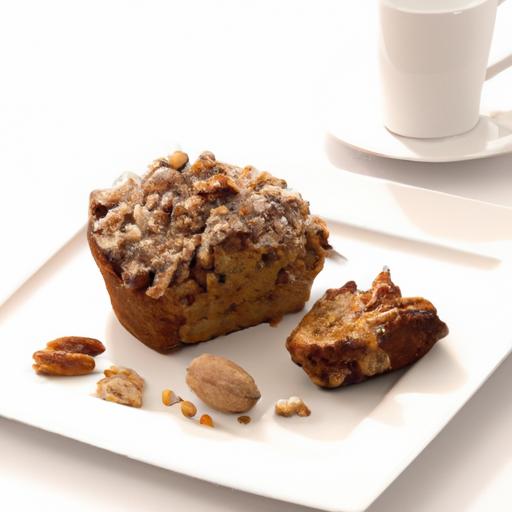In the heart of every kitchen, a humble food processor whirs away, promising convenience and versatility. But when it comes to transforming sturdy nuts into fine, delicate flour, can this trusty appliance truly rise to the challenge? Grinding nuts to flour isn’t just about pulverizing-they demand a balance of precision and patience to unlock their full potential without turning into butter. In this article, we dive into the nuts and bolts of using a food processor for this task, exploring its strengths, limitations, and expert tips to achieve that perfect nutty powder. Whether you’re a baking enthusiast or a curious home cook, discover if your food processor can really do the job-and how to make it work harder for you.
Understanding the Texture Differences Between Nut Flour and Nut Butter
Grinding nuts to flour: can a food processor do the job? Absolutely. Yet, understanding the subtle but crucial differences in texture between nut flour and nut butter is key to mastering this skill. Nut flour is finely ground nuts with a dry, powdery consistency, perfect for baking and gluten-free cooking. On the other hand, nut butter is a creamy, spreadable paste achieved by continued processing that releases the oils from within the nuts, transforming their structure entirely.
When your goal is to create a light, crumbly flour, the processing time must be just right-too long and you risk slipping into nut butter territory. The particle size in nut flour should be uniform and fine, almost like traditional grain-based flours. This impacts how it blends in recipes and its moisture absorption.
Choosing the Right Food Processor for Grinding Nuts Effectively
Not all kitchen gadgets are equally matched for grinding nuts to flour. For best results, a food processor with a powerful motor of at least 600 watts and sharp, sturdy stainless steel blades is essential. Lower-wattage models may struggle or overheat, hindering your progress and leading to uneven textures.
Additionally, a medium to large food processor bowl-ranging from 7 to 12 cups-allows you to grind nuts in manageable batches without overloading the machine. Choose a model with pulse functionality to maintain precise control, allowing you to stop before the nuts release too much oil.
Techniques to Achieve Fine Nut Flour with Your Food Processor
- Start with dry, fresh nuts: Ensure your nuts have no added oils or moisture, as this can cause clumping.
- Work in small batches: Fill the bowl no more than halfway to allow proper movement of nuts and blades.
- Pulse, don’t run continuously: Use short 10-15 second pulses, shaking or scraping the sides between to promote even grinding.
- Watch for texture changes: Stop when the mixture resembles a coarse sand transitioning to fine flour. Avoid processing beyond this point.
- Optional sifting: After grinding, sift the flour through a fine mesh sieve to separate any larger particles and return them to the processor for a second pass.
Troubleshooting Common Challenges When Making Nut Flour at Home
Even with the right equipment, nuances in nut flour preparation can pose challenges. If your ground nuts start to release oil, resulting in a paste, it’s usually because of over-processing or using nuts with too much natural oil content (e.g., macadamias). To counter this, chill your nuts for 30 minutes prior to grinding to reduce oil flow.
If the flour becomes clumpy and uneven, try adding a tablespoon of rice flour or arrowroot powder to absorb excess oil. Another tip is to give your machine breaks during processing to avoid heat buildup which can accelerate oil release.
Lastly, cleaning the processor immediately after use prevents residual oils from rancidity and ensures consistent texture in future batches.
Prep and Cook Time
- Preparation: 5 minutes (for measuring and chilling nuts)
- Grinding: 5-10 minutes (including pulsing and sifting)
- Total Time: 10-15 minutes
Yield
- Approximately 1 cup of fine nut flour per 1 cup of whole nuts processed
Difficulty Level
- Easy to Medium
Ingredients
- 1 cup raw almonds, skin on or off depending on preference
- Optional: 1 tbsp rice flour or arrowroot powder (for oil absorption)
Instructions
- Chill the raw almonds in the freezer for 30 minutes to slow oil release during processing.
- Place half the almonds into the food processor; do not overfill to ensure even grinding.
- Pulse in short bursts of 10-15 seconds. After each pulse, stop and scrape down the sides to prevent clumping.
- Continue until the nuts resemble a coarse meal, then transition to finer flour without continuing too long to avoid butter formation.
- Sift the ground almonds through a fine mesh sieve to separate any larger pieces; return those to the processor for a second grind.
- If oiliness occurs, add 1 tablespoon of rice flour or arrowroot powder and pulse briefly to absorb excess oils.
- Repeat the process for the remaining nuts, then combine all flour batches and store in an airtight container.
Tips for Success
- Maintain your food processor blades sharp for efficient grinding.
- Use raw, unsalted nuts to preserve natural flavor and control moisture content.
- Experiment with different nuts (walnuts, pecans, hazelnuts) but remember oil content affects texture.
- Store nut flour in a cool, dry place or refrigerate to preserve freshness.
- Use leftover larger pieces in smoothies or granola recipes to reduce waste.
Serving Suggestions
Use your freshly ground almond flour as a nutrient-rich substitute in pancakes, muffins, or gluten-free cakes. It provides delicate, nutty undertones that elevate simple recipes to artisanal heights. Garnish baked goods with slivered almonds or a dusting of powdered sugar for visual and textural contrast.
For a savory twist, mix nut flour into coatings for chicken or fish, then finish with fresh herbs for an elegant, crispy crust.
| Nutritional Info (per 1/4 cup almond flour) | Amount |
|---|---|
| Calories | 160 kcal |
| Protein | 6 g |
| Carbohydrates | 6 g |
| Fat | 14 g |

Looking for more inspiration? Discover how to make your own nut butters for luscious spreads. For a deeper dive into food processor selection, visit Consumer Reports’ comprehensive guide.
Q&A
Grinding Nuts to Flour: Can a Food Processor Do the Job?
Q&A
Q1: Can a food processor really turn nuts into flour?
Absolutely! A food processor is a versatile kitchen wizard that can transform whole nuts into a finely ground flour. With the right technique, it’s a great shortcut to homemade nut flours without the need for special equipment.
Q2: How fine can the nut flour get using a food processor?
While a food processor can get you close to a fine, powdery consistency, it usually won’t be as silky smooth as store-bought nut flour ground in specialized mills. You’ll end up with a slightly coarser texture, perfect for many baking recipes and cooking applications.
Q3: Does the type of nut affect the outcome?
Yes! Softer nuts like almonds and cashews grind more easily, producing smoother flour. Harder nuts like walnuts or pecans may be a bit more crumbly and oily, so your flour might be a tad clumpier and richer in texture.
Q4: Are there any tips to prevent nuts from turning into nut butter?
Great question! To avoid ending up with nut butter, pulse the nuts in short bursts rather than running the food processor continuously. Also, avoid over-processing-the natural oils in nuts release quickly and can cause the mixture to clump and turn creamy.
Q5: Do I need to prepare the nuts before grinding?
For best results, it’s helpful to lightly toast the nuts first (optional) and ensure they are fully dry. You can also chill them beforehand, which helps reduce the chances of the nuts releasing too much oil during grinding.
Q6: How much nut flour can I make at once?
Food processors vary in size, but it’s best to work in small batches-about 1 to 2 cups at a time. This ensures even grinding and prevents overheating or sludging.
Q7: Is homemade nut flour just as good as store-bought?
Homemade nut flour often boasts fresher flavor and no additives, making it a healthful, cost-effective alternative. Just keep in mind the slightly coarser texture and shorter shelf life due to natural oils.
Q8: What are some creative ways to use homemade nut flour?
From gluten-free baking masterpieces and crunchy coatings for meats to thickening sauces and adding nutritional punch to smoothies, homemade nut flour is a kitchen chameleon. Let your imagination run wild!
In summary: Yes, your trusty food processor can indeed pulverize nuts into flour, unlocking new culinary possibilities right in your home kitchen. With a bit of patience and technique, you’ll be crafting nutty flour magic in no time!
To Conclude
In the quest to transform crunchy nuts into fine, flour-like powder, the humble food processor emerges as a versatile kitchen ally. While it may not rival specialized grain mills in precision, with the right technique and a bit of patience, it can certainly rise to the occasion-turning whole nuts into the basis for gluten-free baking, hearty crusts, or flavorful coatings. So next time you find yourself reaching for almond or hazelnut flour at the store, consider the food processor lurking on your countertop. With a few pulses here and there, you might just unlock a fresh, nutty ingredient crafted by your own hands-and perhaps even a newfound appreciation for this everyday gadget’s culinary potential.


